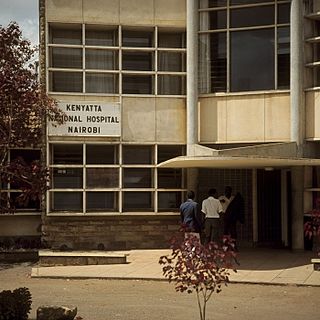
The Kenya African National Union (KANU) is a Kenyan political party that ruled for nearly 40 years after Kenya's independence from British colonial rule in 1963 until its electoral loss in 2002. It was known as Kenya African Union (KAU) from 1944 but due to pressure from the colonial government, KAU changed its name to Kenya African Study Union (KASU) mainly because all political parties were banned in 1939 following the start of the Second World War. In 1946 KASU rebranded itself into KAU following the resignation of Harry Thuku as president due to internal differences between the moderates who wanted peaceful negotiations and the militants who wanted to use force, the latter forming the Aanake a forty, which later became the Mau Mau. His post was then occupied by James Gichuru, who stepped down for Jomo Kenyatta in 1947 as president of KAU. The KAU was banned by the colonial government from 1952 to 1960. It was re-established by James Gichuru in 1960 and renamed KANU on 14 May 1960 after a merger with Tom Mboya's Kenya Independence Movement.
Wundanyi is a town in the Taita-Taveta County of Kenya. Other urban centres in the county include Voi, Taveta and Mwatate.

Malindi Airport is an airport in Kenya.

The Kenyatta National Hospital is the oldest hospital in Kenya. It is a public, tertiary, referral hospital for the Ministry of Health. It is also the teaching hospital of the University of Nairobi College of Health Sciences. It is the 2nd largest hospital in the country and East Africa as well.

Chase Bank Kenya Limited(CBK), commonly referred to as Chase Bank, was a commercial bank in Kenya, licensed by the Central Bank of Kenya, the central bank and national banking regulator.
Kingdom Bank Limited (Kenya), formerly Jamii Bora Bank, is a commercial bank in Kenya. It is one of the commercial banks licensed by the Central Bank of Kenya, the national banking regulator.

Upper Hill is a neighbourhood of the city of Nairobi, the capital and largest city of Kenya. The district has seen an increase in major construction in recent years, with several multinational corporations setting up offices.
Kenya Commercial Bank Plaza (KCB Plaza) is a building in Nairobi, the capital and largest city of Kenya. Construction began in December 2010 and the building was completed in 2015.
Wajir Airport is an international airport in Wajir County, Kenya.
Nyeri Airport is an airport in Nyeri County, Kenya.
Naivasha Airport is an airport in Naivasha, Kenya.
Embu Airport is an airport in Kenya.
Hola Airport is an airport in Kenya.
Magadi Airport is an airport near Magadi, Kenya.
Rhamu, known to the locals as "shantooley", is a town in the Mandera County of Kenya situated in the northeastern part of Kenya, approximately 15 kilometers east of the River Dawa. The town lies within a semi-arid region characterized by dry and hot conditions, with limited rainfall and sparse vegetation.. It is largely populated by the Garre and Murule Somali as well as a substantial settlement of Degodia clan on the north western side. The town was previously built by the british colonial administration and was the border between Quranyow-Banna section of the Garre tribe and Murule Rhamu is located at the international border between Kenya and Ethiopia. Due to its proximity to Ethiopia, Rhamu has historically been a center for cross-border trade. Local traders engage in the exchange of goods, including livestock, agricultural products, and other commodities with their Ethiopian counterparts.
Mavueni is a neighborhood in the city of Kilifi, in Kenya's Kilifi County.
The Olkaria IV Geothermal Power Station is an operational geothermal power plant in Kenya, with installed capacity of 140 megawatts (190,000 hp).
Kenyatta University Solar Power Station is a 10 MW (13,000 hp) solar power plant under construction in Kenya.
Cytonn Towers is a planned mixed-use skyscraper development, consisting of three towers of 35 storeys each, in Nairobi, Kenya's capital and largest city. The development is targeted towards the upper middle class, non-governmental organisations and diplomatic missions.
The Nairobi Southern Bypass Highway is a road in Kenya, forming a semi-circle through the south-western neighbourhoods of the capital city of Nairobi. The road allows traffic from Mombasa, destined for western Kenya and Uganda to bypass downtown Nairobi, thereby reducing traffic congestion in the city's central business district.






